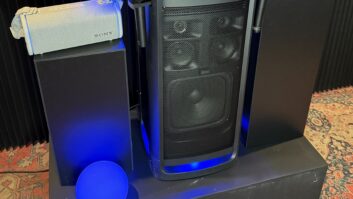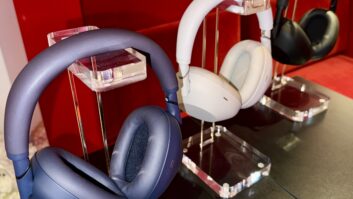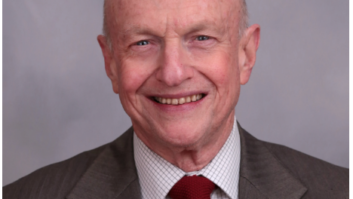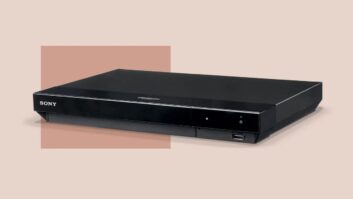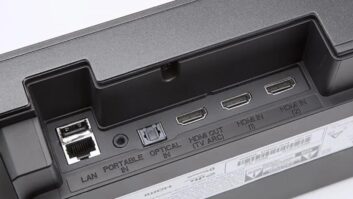During a time of transition, when Sony Electronics is moving its headquarters from New Jersey to San Diego, and is battling with both existing and new competitors, president/COO Dick Komiyama was optimistic and realistic about company prospects, during a press roundtable here last Thursday.
During a period where many long-time executives left Sony due to the San Diego move, Komiyama claimed that in the most recent fiscal year, ended March 31, consumer electronics produced “in the U.S. one of the greatest results in the history of Sony.”
Since April, “we kept sales momentum going with Sony consumer electronics sales achieving significant profit levels far surpassing our target.” While not providing hard numbers, Komiyama added that Sony kept its No. 1 market share in such categories as camcorders, personal audio, color TV, digital cameras, home audio, VCR and DVD.
The decision to move its headquarters to San Diego, part of a “major transformation” of the company, was to be completed in March 2006, but will be completed a year earlier, he noted.
The move was made “due to a changing business environment. We need to put all our resources together in one place,” he said. And while Sony has had “many loyal employees on the East Coast,” the company saw the business changing, with CE merging due to technology with the IT, networking and wireless areas, Komiyama noted. “In order to build Sony for the future [the move] was needed. We tried to minimize the [problems of] the transition. We did achieve an improvement in our business in the last fiscal year and in this one.”
He added that while the departure of key longtime sales and marketing was difficult, “top level managers” are still there due to the “depth of talent,” such as Mark Viken, corporate marketing senior VP; Mike Fidler, Home Products senior VP; and many others.
Among the changes Sony faces as it deals with a converged CE marketplace with manufacturers from IT, networking and wireless, as well as new geographic competitors from China and other parts of Asia, is the commodity factor and the erosion of branding.
Komiyama stated Sony should keep its premium position because consumers “don’t just look for one single device. They look for ease of use, the assurance of quality, providing content and service. That’s what we believe continues to make Sony different than all the others.”
Due to the new challenges from other industries, and new suppliers worldwide, Sony has been criticized in some quarters for losing its edge and not being as cutting-edge as it once was. Komiyama said to maintain growth “the force that drives Sony is the spirit of innovation.”
One area under challenge is “Personal Entertainment,” featuring the Walkman, which may have been replaced in some quarters as a personal audio icon by Apple’s iPod. Sony is bolstering this core category with a variety of Walkman products, such as Hi-MD Walkman, Net MD Walkman and ATRAC CD Walkman, as well Network Walkman players and VAIO pocket devices. That area has gotten a significant push since the spring, with its promotional tie-ins with McDonald’s and Connect.com music service.
(In answering questions Sony executives present reported that Connect.com have 700,000 to 800,000 songs available now, and could be offering movies in the near future.)
In discussing iPod’s place in the market, Komiyama explained the portable audio category “hard disk players are less than 10 percent of the share,” but are “catching up,” and Sony has to emphasize “our strengths in entertainment and technology to [become] a new Sony in the market.”
Several other areas are critical to Sony’s near future, such as the “Digital Living Room.” While continuing to push that the CRT-based TV business is “still active,” is 70 percent of the market, and is the high-end choice for the best in HDTV, Sony will also put an emphasis on flat-panel TV technology.
As part of Sony’s push to remind consumers of its leadership in HDTV, the company has established “key partnerships’ with Cox Cable to produce San Diego Padres games in HDTV, and becoming NBC’s partner in HD Summer Olympics coverage.
As for VAIO and its role with Sony, it is now emerging as “VAIO World, representing computers and related devices,” Viken said, such as the new concept and ultra-thin X505 Notebook. Komiyama noted that the new notebook has been “accepted very well because it is unique.”
For instance, Komiyama noted that marketing and communications have been combined to “put all of our ideas in one voice.”
A major part of that strategy is the “Sony — Like No Other,” unified ad campaign that was introduced at CES and will take off during the second half with spots featuring Macy Gray and Aerosmith, among others featuring the Network Walkman NW-HD1, as well as separate spots featuring the DVD camcorder line and others, according to Viken.
While Viken did not provide dollar figures, he said Sony will double its consumer advertising budget during the fiscal year ending March 31, 2005.
For more on Sony’s product plans and strategies, see the July 26 issue of TWICE.




